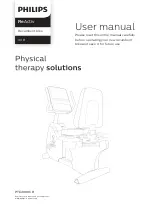
24
E N G L I S H
ADJUSTMENTS
WARNING: you must get off the bicycle to make any adjustments (seat, handlebars).
HOW DO YOU ADJUST THE POSITION OF THE SEAT
AND THE HANDLEBARS?
For an effective workout, the seat and handlebars must be adjusted
properly.
While you are pedalling, your knees should be slightly bent when the
pedals are in the lowest position.
In order to adjust the seat, unscrew and pull the knob on the seat post.
To lock it, reinsert the thumb wheel into the seat tube and tighten it
completely.
Next, repeat the same operation for the handlebars.
To find the position corresponding to your height, please refer to the
table below titled: «Adjusting the Handlebars»:
IMPORTANT:
make sure that you put the
knob back into place in
the seat post and tighten it
completely.
Never exceed the maxi-
mum seat height.
IMPORTANT:
Never exceed the maxi-
mum handlebar height
4
1
Height in cm
Adjusting the height
155 à 160
1
161 à 166
2
167 à 172
3
173 à 178
4
179 à 184
5
185 à 190
6
191 à 195
7
2
3
4
1
Height in cm
Adjusting the seat
0 <155
0
155 à 160
1
161 à 164
2
165 à 169
3
170 à 173
4
174 à 177
5
178 à 181
6
182 à 186
7
187 à 195
8
>195 9
3
2
1
HOW TO ADJUST THE PEDAL STRAPS ?
The new-generation toe clips are easy to use and require no adjustment.
LEVELLING THE BICYCLE
In the event that the bike becomes unstable during use, turn one or both of the plastic end knobs on the rear support
leg until the bike is stable.
ADJUSTING THE RESISTANCE:
According to the EN (European Norm) defi nition, this product is an item of “pedal crank training equipment”.
You can adjust the braking torque not only with your pedalling speed but also by manually choosing your
resistance level (by turning the torque control knob on non-motorised products and by pressing the +/- buttons
on motorised products). However, if you retain the same level of resistance, the braking torque will increase/
decrease as your pedalling speed increases and decreases.
3






































